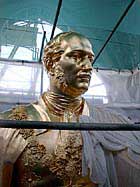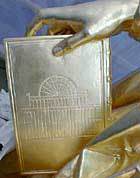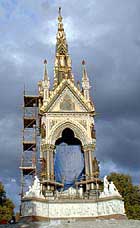

![]()
The Albert Memorial
 |
Sir Gilbert Scott's statue of Prince Albert, in the recently restored Albert Memorial, in all its gilded glory |
A year after the removal of the Crystal Palace to Sydenham from Hyde Park in 1852, it was proposed to erect a memorial to the Great Exhibition that had been the reason for it being constructed. This was to include a statue of Prince Albert, the originator of 'this display of the industry of all nations'.
However, the spot finally chosen was to the west of the ground covered by the exhibition, and with the prince's death in 1861, the focus of the memorial became Albert himself. It was erected directly opposite the new Royal Albert Hall and facing the South Kensington establishments -- the museums and the Imperial College -- in which the Prince Consort had always taken so deep an interest.
Taking more than 20 years to complete and costing in excess of £130,000, the memorial was designed by Sir Gilbert Scott. A high pyramid of three quadrangular ranges of steps forms the base of the monument. Above this is a large statue of the prince, placed beneath a vast, gorgeous Gothic canopy about 30 ft [9.14m] square, supported at the corners by groups of columns of polished granite and 'surrounded by works of sculpture, illustrating those arts and sciences which he fostered, and the great undertakings which he originated'.
The memorial is 176 ft [53.64m] high, and the first flight of granite steps, forming the base, is 212 ft [64.62m] wide.
At the four corners of the second flight of steps are great square masses of carved granite on which are colossal groups of marble statues representing Europe, Asia, Africa and America. The 15-ft [4.57m] pedestal on which stands the statue of the prince is carved with nearly 200 life-size figures, portraits of various celebrities in art, literature, science and so on. On the four corners of this are allegorical groups of statues: commerce, manufactures, agriculture and engineering.
 |
the catalogue in the hand of Prince Albert, showing an elevation of the Crystal Palace |
The statue of the prince, which was not completed until 1876, is richly covered in gilt and shows Albert sitting on a chair of state and attired in his robes as Knight of the Garter. He is holding a catalogue of the Great Exhibition.
The roof of the canopy is decorated with mosaics of the arms of Queen Victoria and of the prince himself on a ground of blue and gold. At the angles of the four arches above the canopy are life-size marble figures. The arch spandrils above the trefoil are filled with rich and elaborate glass mosaics on a gilt ground portraying poetry, painting, sculpture and architecture.
The spire above the canopy is covered with ornament. Much of its surface is coated in coloured enamels and marbles, as well as imitation gem-work. The cross, which surmounts the whole, has the same extraordinary amount of detail, as if each part was meant for close inspection.
 |
The Albert Memorial after restoration, just before it was unveiled by HM The Queen on 22 October 1998 -- a restoration costing £11 million |